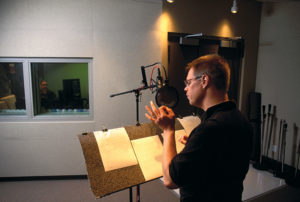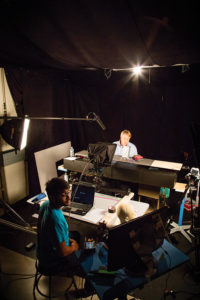‘Engineer Guy’ Bill Hammack
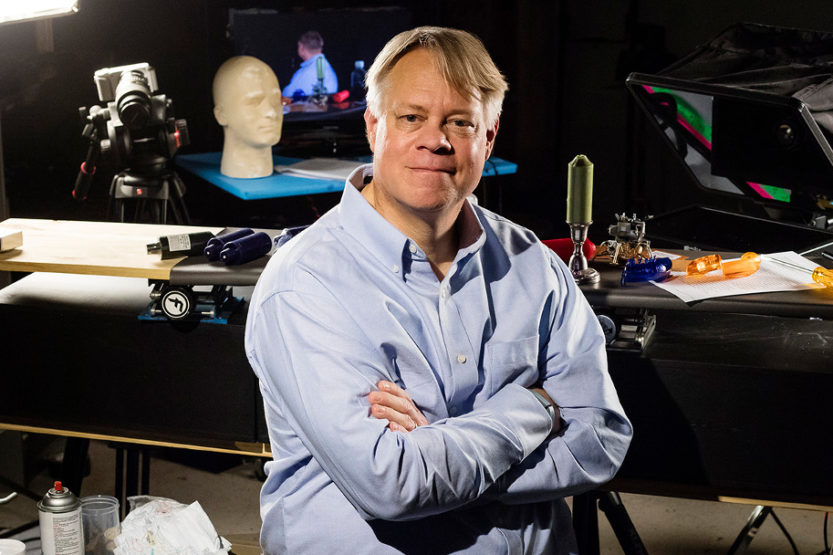 "Engineer Guy" Bill Hammack. (Photo by L. Brian Stauffer)
"Engineer Guy" Bill Hammack. (Photo by L. Brian Stauffer) Bill Hammack’s unlikely YouTube career falls into three distinct periods. Each is linked to a shirt. In his first set of video segments—when he started down the road to online fame—Hammack, MS ’86 LAS, PHD ’88 LAS, favored a blue shirt of a vibrant hue, offset by a brown sweater vest. It was a period of wild fun, though that wackiness always remained true to the basic principles of engineering as it is embedded in everyday life. In his second period—which we’ll deem his “classic” phase—Hammack sported highly photogenic red. In his third, and current, period of videos—which draw online audiences of six and seven figures—he wears light blue. In all three, he and his shirts inhabit a persona known as “Engineer Guy.”
A professor in the department of chemical and biomolecular engineering, Hammack is wont to downplay videos from his early blue-shirt-brown-vest days, recently removing them from his website, www.engineerguy.com. This is a pity, as the spots are delightful—like the one in which he disassembles the department photocopy machine to the chagrin of the department secretary (who comes across as a pretty good actress). Or the ones where he guillotines a bucketful of golf balls (this lesson is about polymers), lip syncs to Doris Day (Geiger counters) and cuts pipes out of the ceiling of his TV studio “office” (copper). In each, he is introduced as the department’s “Walter Mitty Chair”—Mitty, of course, being the fantasy-driven creation of humorist James Thurber.
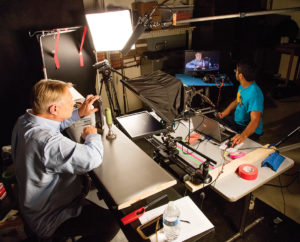
Illinois Professor Bill Hammack—aka the “Engineer Guy”—in his video studio where he takes everyday objects, ranging from candles to beverage cans, and uses them to illustrate engineering principles. His demonstrations on YouTube have resulted in 210 million views. (Photo by L. Brian Stauffer)
“We were kind of silly,” Hammack says of that first series, which ran from 2006-10. “We didn’t understand the medium. YouTube, we thought, was light and goofy. But really, what YouTube tries for is authenticity. If you’re excited about LCD monitors, and you just go on and talk about LCD monitors, it will resonate with people.”
And Bill Hammack being Bill Hammack, he’s right. Shot against a black backdrop and delivered more or less “straight” in his resonant voice, Engineer Guy’s LCD monitor teardown has attracted more than 1 million views since it was posted in 2011. An 11-minute segment on the design and manufacture of aluminum beverage cans has accumulated almost 1.8 million hits. A million of those hits came on the release date, April 14, 2015, and three-quarters of that million were in the first hour. Dozens of other segments have attracted thousands of views. The Engineer Guy at UI is a YouTube phenomenon.
Deconstructionist
Hammack writes, performs, produces and releases the telepieces, for which he fearlessly combs the field of engineering in search of familiar hardware to deconstruct: smoke detector, light-bulb filament, coffeemaker, hard drive, quartz watch, atomic clock. He also takes apart problems and processes. Want to know why VHS won out over Betamax or how the image flips from horizontal to vertical on a smartphone or how information flows through fiber-optic cables? Check out the Engineer Guy—a moniker that Hammack says came to him as an easily run-together URL for his website. “In the early days, I considered Prairie Engineer,” he recalls. “But prairie is too hard to spell.”
With help from a series of co-creators—he currently works with postgraduate researcher Steve Kranz, MS ’13 ENG—Hammack shoots the videos in a TV studio he built in Roger Adams Lab on South Mathews (where he also has his office) in Urbana and augments them with photography and animation. He then shares his work with a volunteer coterie of advance viewers, using their reactions and suggestions to fine-tune each segment. A new video goes up every month or two on the Engineer Guy YouTube channel, which Hammack promotes through Reddit and Facebook. He also teaches basic engineering courses on campus and writes books—including a coffee-table volume about a mechanical harmonic analyzer built in the 19th century, an anthology of his radio pieces, a companion volume to his video work and Why Engineers Need to Grow a Long Tail, a 2010 meditation on social media.
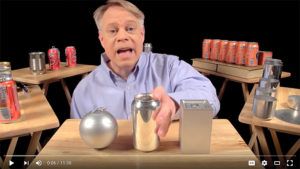 Hammack’s forays into engineering have a way of making viewers see the world anew. “To us, the ideal video is about something you see every day and take for granted,” he says. “And we remind you that the engineering of it is actually really complex”—like the wall-unit air conditioner he and Kranz bought last summer for $120 on Amazon. Having convinced University maintenance workers to drain the unit of its Freon and saw it open, Hammack and Kranz peered into the innards for a long time in search of an explanation and a script. (The piece is still in progress.) “The core of engineering is choice,” Hammack says. “And the air conditioner comes to mind because it baffles us right now.”
Hammack’s forays into engineering have a way of making viewers see the world anew. “To us, the ideal video is about something you see every day and take for granted,” he says. “And we remind you that the engineering of it is actually really complex”—like the wall-unit air conditioner he and Kranz bought last summer for $120 on Amazon. Having convinced University maintenance workers to drain the unit of its Freon and saw it open, Hammack and Kranz peered into the innards for a long time in search of an explanation and a script. (The piece is still in progress.) “The core of engineering is choice,” Hammack says. “And the air conditioner comes to mind because it baffles us right now.”
Bafflement does not preclude fun. In 2012, exploratory surgery on a microwave oven produced a hilarious video of outtakes—“Why it takes a while to make engineerguy videos”—in which the microwave, along with other props, variously falls over and apart, alongside the Engineer Guy’s normally flawless narration.
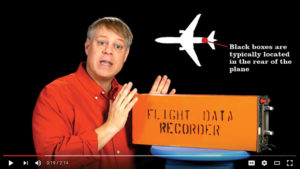 Inspired by Carl Sagan
Inspired by Carl Sagan
Hammack’s dual talent for science and performance dates from birth. His mother was a botanist, and his father taught theatre at Central Michigan University. Bill was just nine years old when he found the university library, a few blocks from his family’s home in Mount Pleasant. The many hours he spent there are reflected in his lifelong love of reading as well as his writing, which is leavened with references to Montaigne and Austen and Orwell and Borges. His affinity for science and numbers steered him into chemical engineering studies at Michigan Tech and then to a doctorate at Illinois in 1988. From there, the future pointed toward a decade of research and teaching at Carnegie Mellon in Pittsburgh. And then the future began to shift.
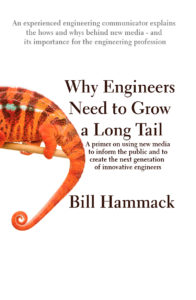
Hammack has written several books, including Why Engineers Need to Grow a Long Tail and How Engineers Create the World. The latter is an anthology of his radio pieces, Engineering and Life, which first aired on Illinois Public Radio (WILL-FM) in 1997. (Image courtesy of Bill Hammack)
“The kind of work I was doing was a little old-fashioned, and I didn’t see huge growth potential in it,” he says of those years. Hammack did see potential in what astronomer Carl Sagan had accomplished. Sagan created Cosmos, a 1980s public television show that entertained and educated hundreds of millions of viewers about science and the universe. Engineers, Hammack believed, also should alert the world to their work—and he was the engineer for the job. Impressed by his reasoning, Charles Zukoski, then head of chemical engineering at UI, created a faculty position for Hammack that emphasized outreach—a nonconforming avenue in a discipline stratified by research and grant money.
“It worked out very well,” recalls Zukoski, now provost at the University of Buffalo. “Bill is a very creative individual who decided where he wanted to have his impact. The courage to do that ought to be recognized.”
Returning from Pittsburgh to Champaign-Urbana in 1997, Hammack went to work on Engineering and Life, a series of radio commentaries that combined personal anecdotes with history of technology and engineering insights. His passion for literature and his own skills as a writer are apparent in these thoughtful essays, which were broadcast on WILL-FM (an affiliate of National Public Radio housed at Illinois), NPR’s Marketplace (a daily show with an audience of 8 million) and public radio in Australia.
“Not everybody can just walk in and do this stuff,” says Jay Pearce, former program director at WILL-FM. “Bill knows how to take direction and how to write. On camera, he comes across as someone you can trust. And he’s like that in person.” Recorded two or three at a time and aired weekly, the radio essays eventually numbered around 300. Many are anthologized in Hammack’s book How Engineers Create the World, and some are archived on the Engineer Guy website, where they make entertaining podcast downloads. “Every morning, I stare into my bathroom mirror and use a technological marvel that cost three-quarters of a billion dollars to develop,” Hammack says in one essay. “It is, of course, my razor.” In another: “Upon marriage, I received my wife’s dowry: a can of Spam.” Subjects range from Lava Lamps, elevators, O-rings and roller coasters to Kalashnikovs, Slinkys, a Norwegian bridge designed by Leonardo da Vinci and how to cook a turkey.
Hammack’s radio days lasted until 2005, when the U.S. State Dept. invited him to Washington, D.C., as a Jefferson Science Fellow. He worked there as an advisor on the Korean Desk, specializing in measuring nuclear proliferation and its impact on the Korean Peninsula. His return to campus a year later also brought home the power of the Internet. He donned his blue shirt and brown vest and went to work, improvising in the TV studio and adapting his fluid prose to video, which he describes as “writing in bubbles.” Hammack—who in person has an impish, quirky air and the appearance of having cut his own hair—evinced then, as he does now, an engaging and authoritative telepresence. He now has more than 386,000 YouTube subscribers and 210 million views.
“Video is the way to go,” he says. “But it’s much harder than radio. We can spend a month or more on research. That’s the hard part. And the unknown part.”
Future engineers
Hammack has received honors and recognition from prestigious societies in mechanical engineering, chemistry, physics, electrical engineering and engineering education. His work also has been recognized by the National Association of Science Writers and the Science OnLine Film Festival. Funding for his videos comes from The Camille & Henry Dreyfus Foundation and the University’s public engagement office. The payoff, for Hammack, is knowing that the videos are “out there in this new media [channel] that’s forever accessible—until the Internet explodes or the Western world disappears.”
The big reach and the long game are especially important in inspiring engineers of the future. “Our demographic skews fairly young,” Hammack says. “I regularly get emails that say something like, ‘I started watching the videos when I was 14. I am now an electrical engineering student.’”
Both recent and forthcoming video releases attest to his continuing quest to fold the edgy around the universal. In February 2015, he checked an obscure volume out of the UI Library and turned it into a fascinating piece on the Titanic and her sister ships, the Olympic and the Britannic. A planned segment on disposable diapers—“They’re astonishing!”—flows from firsthand experience with his recently born son, Niko.
Hammack looks forward to finally posting “The Chemical History of a Candle,” in which he—clad in red shirt, for the program began several years ago—delivers a five-part series of lectures and chemistry demos by Michael Faraday (1791-1867), the English physicist who established the theory of electrochemistry. (Videos are in the can, and the release is awaiting hard-copy publication of a companion anthology.)“I read Faraday’s lectures on a plane on the way to Detroit,” Hammack says. “I thought they were still really relevant about explaining chemistry to people today.” He notes that Faraday—who identified electromagnetic induction and electrolysis, among other discoveries—“takes you from how a candle burns and why to how humans engage in respiration. What he’s trying to show is the unity of a scientific explanation for understanding the world.”
And that, of course, is what the Engineer Guy does. He creates worlds and demonstrations to help people see the processes and principles that inform their lives. As Hammack speaks in Faraday’s quaint and spirited style, chemical engineer and chemist merge. Bill Hammack does performance science for worlds that are separated by centuries.
So where does the Engineer Guy go in a future of virtual lectureship? Certainly, more potential awaits online in formats large and small. Massive open online courses are open to all, attracting enrollments of 20,000 and up; through the online platform Coursera, they are offered by many top universities, including Illinois. “I think the trend to MOOCs is an interesting thing,” Hammack says. “I don’t know how revolutionary it’s going to be for the University of Illinois.”
The Engineer Guy is drawn more to podcasts, which remind him of his radio days—and, as he reminds us, “I loved doing radio.” But, he admits, like so many faculty members in today’s academic environment, “I’m spread too thin as it is.” After all, he already has MOOC-size numbers online, where his work educates all kinds of people. “Ultimately,” says Hammack, “if you look at the YouTube presence—that, to me, is the place to grow.”

